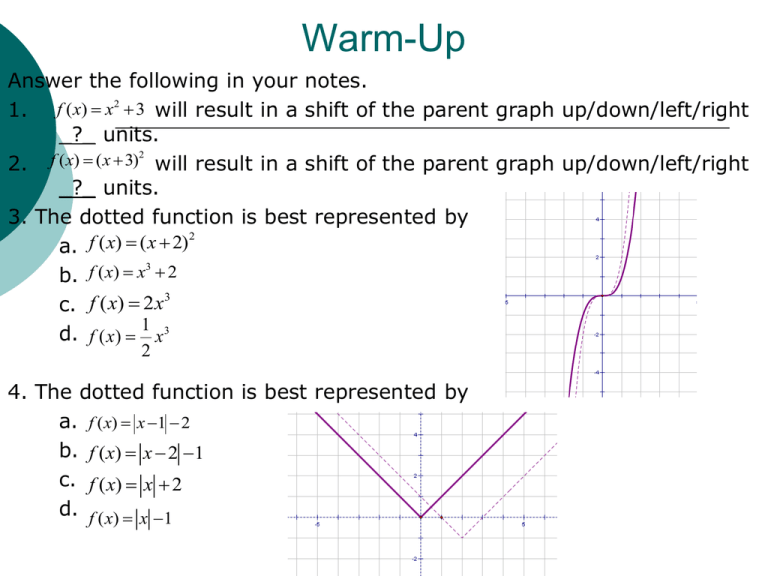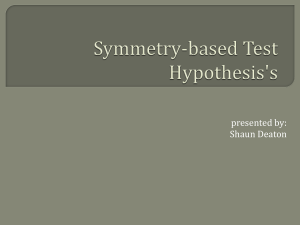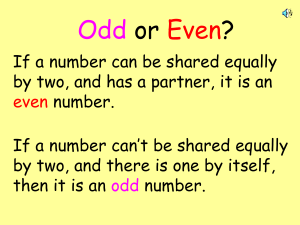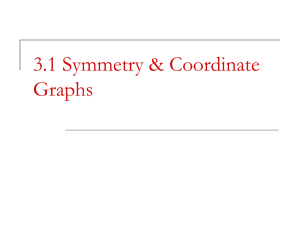Even and Odd Functions
advertisement

Warm-Up Answer the following in your notes. 1. f ( x) x2 3 will result in a shift of the parent graph up/down/left/right _?_ units. 2 2. f ( x) ( x 3) will result in a shift of the parent graph up/down/left/right _?_ units. 3. The dotted function is best represented by 2 a. f ( x) ( x 2) 3 b. f ( x) x 2 3 c. f ( x) 2 x 1 d. f ( x) x3 2 4. The dotted function is best represented by a. f ( x) x 1 2 b. f ( x) x 2 1 c. f ( x) x 2 d. f ( x) x 1 Take out your notebook/binder… It’s NOTE-TAKING time!! Today’s Date => 9/13/10 Today’s 1st Topic => Reflections 2nd Topic => Even/Odd Functions Reflection Symmetry Reflection Symmetry (sometimes called Line Symmetry or Mirror Symmetry) is easy to recognize, because one half is the reflection of the other half. Here is a dog. Her face made perfectly symmetrical with a bit of photo magic. The white line down the center is the Line of Symmetry. Reflection Symmetry The reflection in this lake also has symmetry, but in this case: the Line of Symmetry is the horizon it is not perfect symmetry, because the image is changed a little by the lake surface. Line of Symmetry The Line of Symmetry (also called the Mirror Line) does not have to be updown or left-right, it can be in any direction. ~But there are four common directions, and they are named for the line they make on the standard XY graph. Examples of Lines of Symmetry Line of Symmetry Sample Artwork Example Shape Examples of Lines of Symmetry Line of Symmetry Sample Artwork Example Shape In-Class Assignment (Part 1) Take out one sheet of paper. 1. Write all of the capital letters of the alphabet. Decide which letters have symmetry and write the type of symmetry next to the letter. (Example: A has y-axis symmetry) 2. Reflect numbers 0, 1, 2, 3, & 4 across the x-axis. 3. Reflect numbers 5, 6, 7, 8, & 9 across the y-axis. Even & Odd Functions Degree: highest exponent of the function Constants are considered to be even! Even degrees: f ( x) 5 x 2 f ( x) 4 x 4*1 4 0 Odd degrees: f ( x) x f ( x) 2 x 3 Even Functions EVEN => All exponents are EVEN Example: f ( x) x 7 2 y-axis symmetry f ( x) f ( x) Odd Functions ODD => All exponents are ODD Example: f ( x) x 3x 3 origin symmetry f ( x) f ( x) NEITHER even nor odd NEITHER => Mix of even and odd exponents Examples: 2 3 f ( x) 5 x x 3 4 f ( x) 6 x 2 3 Leading Coefficient (LC) The coefficient of the term with the highest exponent 2 Cases: LC > 0 LC < 0 Agree?!?! End Behavior What happens to f(x) or y as x approaches -∞ and +∞ We can figure this out quickly by the two things we’ve already discussed Degree of function (even or odd) Leading coefficient (LC) Let’s look at our 4 cases…jot these down in your graphic organizer! Case #1: Even Degree, LC > 0 f ( x) x 2 Example: Both ends go toward +∞ Case #2: Even Degree, LC < 0 Example: f ( x) x 2 Both ends go toward -∞ Case #3: Odd Degree, LC > 0 Example: f ( x) x x , f ( x) x , f ( x) “match” 3 Case #4: Odd Degree, LC < 0 Example: f ( x) x x , f ( x) x , f ( x) “opposites” 3 In-Class Assignment (Part 2) 1. 2. 3. Determine if the following functions are even, odd, or neither by analyzing their graphs. Explain why you chose your answer. Write the equation of the function. (You have 2 minutes for each graph) #1 #2 #3 #4 Determine if the following are even, odd, or neither. Then describe the end behavior. 5. f ( x) 3x2 4 3 6. f ( x) 2 x 4 x 7. f ( x) 3x 2 x 4 x 4 2 3 2 2 3 8. f ( x) x 4 x 3 9. 10. f ( x) 5x 9 2 f ( x) 2 x x 3 Answer the following: 11. Explain how you know a function is even, odd, or neither. 12. Write an even function. 13. Write an odd function. 14. Write a function that is neither. 15. What are the four cases for determining the end behavior of a function?











